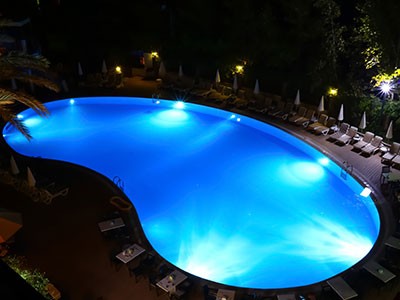If you own an inground swimming pool most if not all these pools have pool lights that besides lighting up the pool water at night can create a beautiful landscape in the dark at night making your pool a beautiful piece of art inviting you to jump in. How Many Pool Lights Do I Need?
The number of pool lights you need depends on the size of your pool. Here are some general guidelines
- -For pools 15′ x 30′ or smaller, you need at least one LED pool light.
- For pools larger than 15′ x 30′, you may need additional light.
- For residential pools larger than 40′ and commercial pools, 3 or more lights may be required.
- For a 20 x 40 pool, you could get away with 2 lights. For a 20 x 42 pool, you probably need 3 lights.
As beautiful as pool lighting can be for you as a pool owner your first consideration should always be safety and pool lighting should keep the entire area of your pool completely lit up for safety reasons when swimming at night.
How Many Pool Lights Do I Need
The number of pool lights needed depends on factors like the size and shape of your pool, desired brightness and coverage, safety considerations, and aesthetic preferences. For a standard-sized pool, one powerful LED pool light can usually provide adequate illumination, but larger pools or those with irregular shapes may require multiple lights for full coverage.
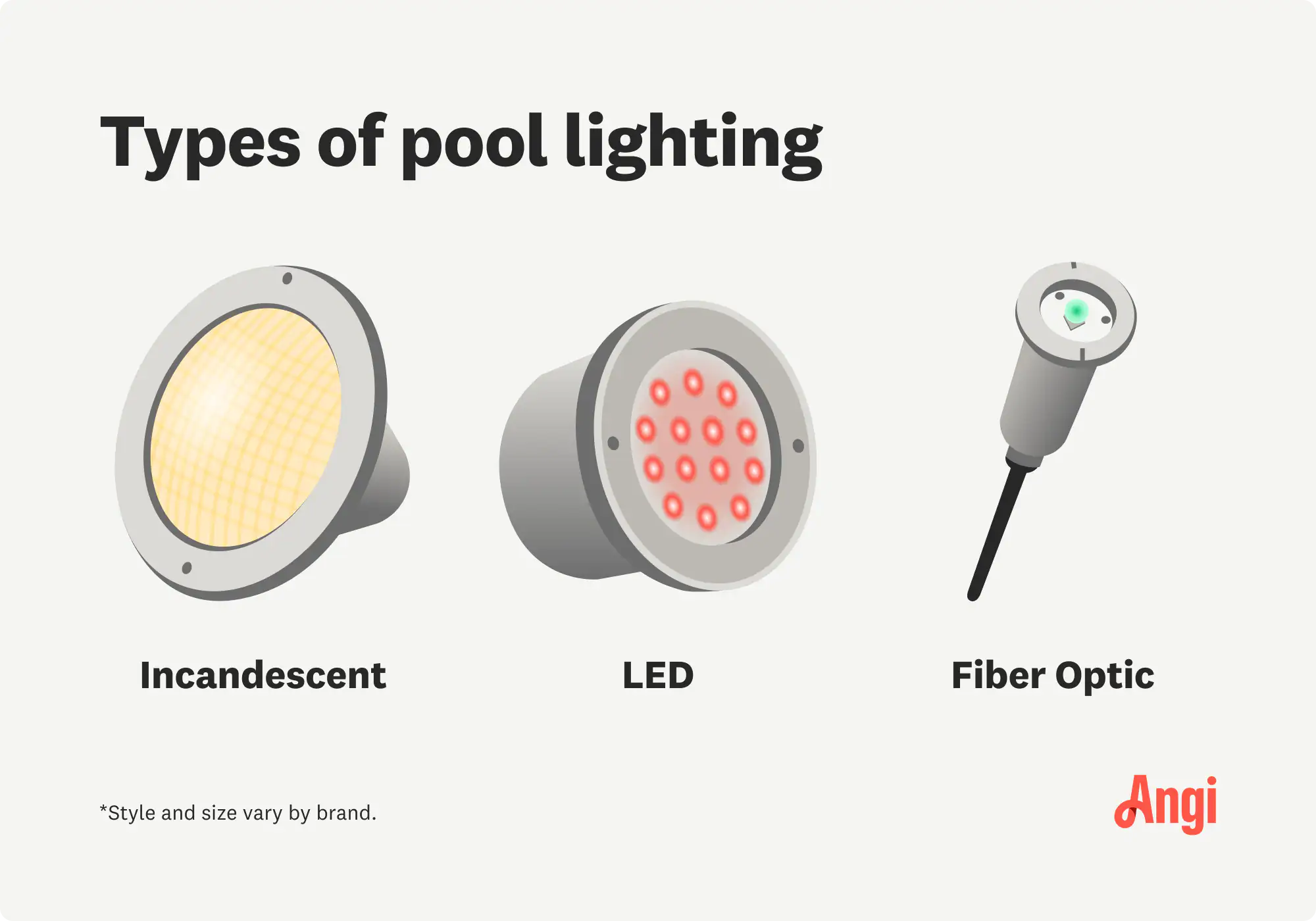
Additionally, considering accent lighting for specific features like waterfalls or entry points can enhance both safety and ambiance. It’s essential to adhere to local regulations regarding pool lighting for safety compliance. Consulting with a professional installer or lighting specialist can help determine the optimal number and placement of lights tailored to your pool’s specific requirements and your desired aesthetic goals.
The number of pool lights you need depends on these factors:
- Pool Size and Shape: Larger pools or irregularly shaped pools may require more lights to adequately illuminate the entire area.
- Brightness and Coverage: Consider the brightness and coverage area of each light. Higher brightness lights may require fewer units to adequately illuminate the pool.
- Safety and Aesthetics: You want to ensure that your pool area is both safe and visually appealing. Sufficient lighting not only allows for safe swimming at night but also enhances the ambiance of your pool area.
- Lighting Design: Some pool owners prefer to have accent lighting or specific areas of focus within the pool, such as water features or entry points. This can influence the number and placement of lights needed.
- Local Regulations: Check with local regulations or codes that may specify requirements for pool lighting, particularly regarding safety standards.
As a general guideline, one powerful LED pool light can typically illuminate a standard-sized pool adequately. However, for larger pools or if you desire more ambiance or safety, you may want to consider adding more lights strategically placed around the pool perimeter or within the pool itself. Consulting with a professional pool installer or lighting specialist can also provide valuable insight tailored to your specific pool setup and preferences.
If you’re looking for an unbeatable combination of energy efficiency and longevity, LED lighting. LED lighting costs a little more upfront than other types of swimming pool lighting but the bulbs last for years and you’ll save on long-term operating costs.
When you look for LEDs, you’ll find a wide range of really cool color-changing pool lights, and many setups come with pre-programmed light shows that are perfect for pool parties. If you want to keep things simpler and cheaper, you can find battery-operated LED lighting or even floating LED lights. But how many do you need?
If you are shopping for pool lights and are wondering how many pool lights you need. The number of lights you need depends on the size of your swimming pool.
- 15’ x 30’ pools only require one light.
- 20’ x 40’ pools require two lights.
- 20’ x 42’ pools and up require three or more lights.
One thing to consider before taking the plunge with LED lighting: LEDs aren’t quite as bright as halogen lights. If your pool is very large or if you want a lot of light, you may need to purchase more LEDs to achieve the lighting look you want.
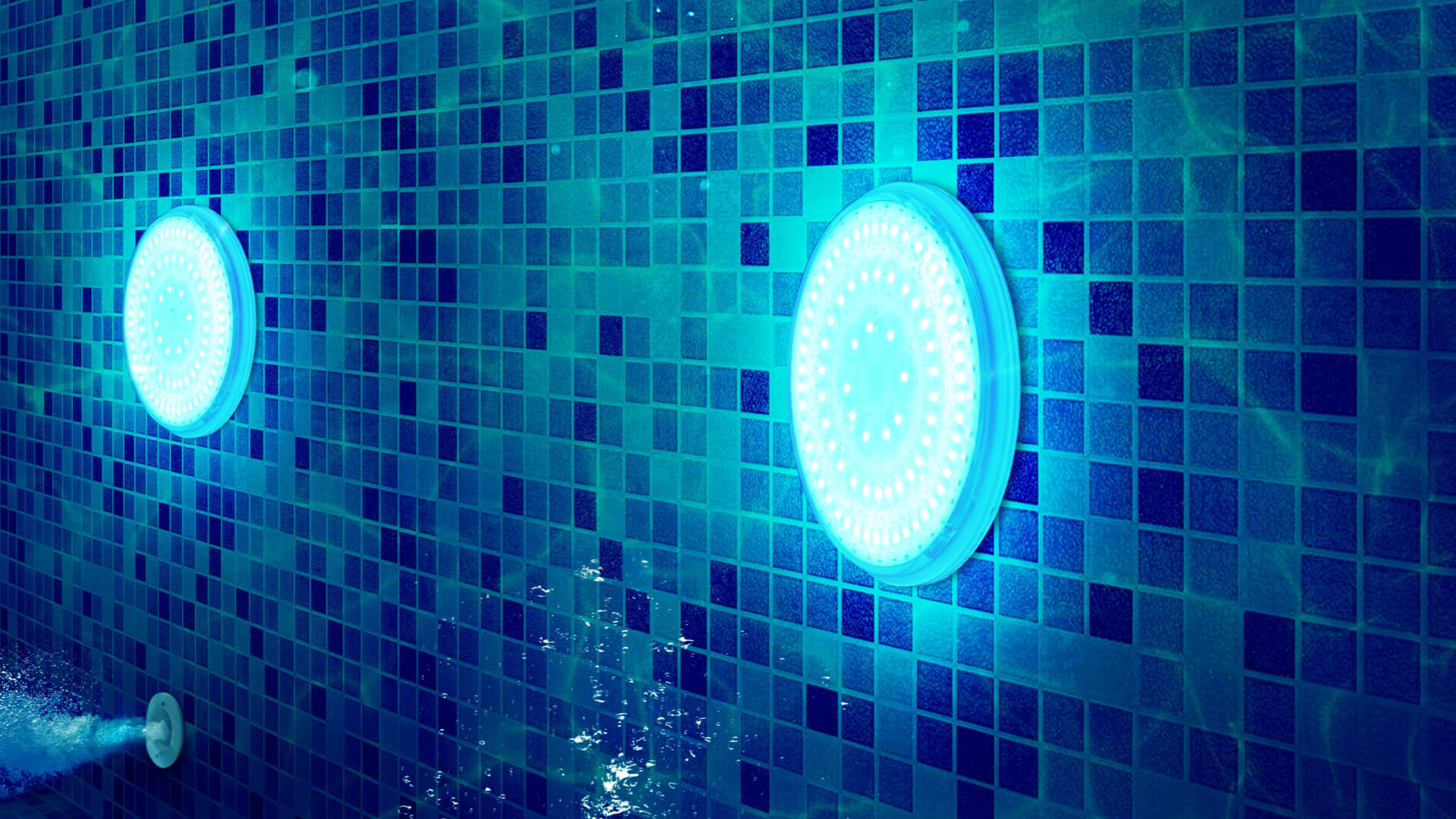
Purpose of Pool Lighting
Pool lighting serves several important purposes:
- Safety: Properly illuminated pool areas are safer for swimming, especially at night. Lights help swimmers see the edges of the pool, steps, and any obstacles, reducing the risk of accidents or injuries.
- Enhanced Visibility: Lighting allows for extended use of the pool area after sunset, enabling swimmers to see clearly and enjoy activities such as swimming, socializing, or relaxing in the water.
- Aesthetics: Well-designed pool lighting enhances the overall ambiance of the pool area, creating a visually appealing atmosphere. Lighting can highlight architectural features, water features, landscaping, and other elements, adding beauty and sophistication to the space.
- Functionality: Pool lights can serve practical purposes beyond basic illumination. They can be used to highlight specific areas of the pool, such as entry points, steps, or water features, making them more visible and inviting.
- Mood Setting: Different lighting options, such as color-changing LEDs or dimmable fixtures, allow pool owners to create various moods or atmospheres to suit different occasions or preferences, whether it’s a lively party or a relaxing evening swim.
Overall, pool lighting not only enhances safety but also contributes significantly to the enjoyment and aesthetics of the pool area, making it a vital component of any well-designed pool environment.
Guidelines for Proper Placement of Pool Lighting
Energy-Efficient LED Technology
If you’re looking for a great combination of energy efficiency and product longevity, you can’t go wrong with LED lighting. LED lighting costs a just little more upfront than other types of swimming pool lighting but the pool light bulbs last for years so you’ll save on long-term operating costs.
And if you want a pool lighting setup with some extra beauty, you won’t be disappointed: When you buy LEDs, you’ll find a wide range of color-changing pool lights, many types come with pre-programmed light shows that will dazzle your friends. If you want to keep things simpler and cheaper, you can find battery-operated LED lighting or even pool water floating LED lights.
One thing to consider before buying LED lighting is that LEDs aren’t quite as bright as halogen lights. If your pool is very large or if you want a lot of light, you may need to purchase more LEDs to achieve the lighting look you want. Energy-efficient LED (Light Emitting Diode) technology has revolutionized the lighting industry, offering numerous benefits for both residential and commercial applications.
LEDs consume significantly less energy compared to traditional lighting sources, making them a cost-effective and environmentally friendly choice. Their long lifespan reduces the frequency of bulb replacements, resulting in lower maintenance costs and less waste. Additionally, LED lights emit very little heat, reducing the strain on cooling systems and making them safer to use in various settings. With advancements in technology, LED lights now offer superior brightness, color options, and dimming capabilities, allowing for customizable lighting solutions tailored to specific needs and preferences. Overall, the widespread adoption of LED technology represents a significant step towards sustainability and efficiency in lighting design and implementation.
Solar Pool Lights
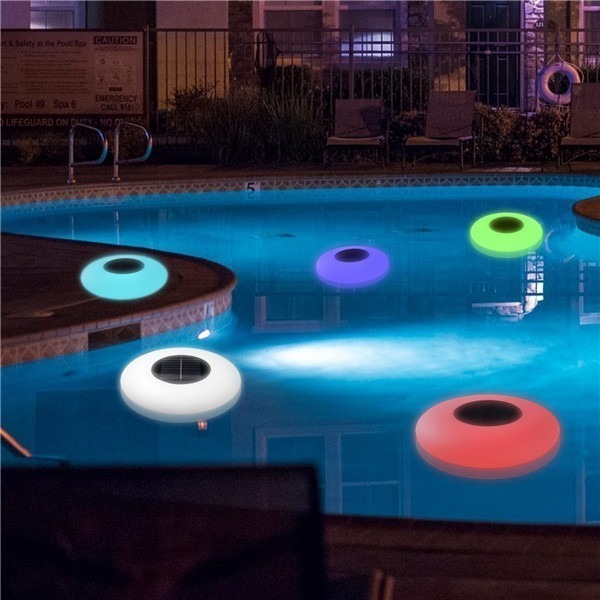
Unlike their LED and halogen pool lights, solar swimming pool lights aren’t meant to light up your whole pool but they are a great option if you’re just looking for a little something extra. Because they’re powered by the sun, solar lights won’t drive up your energy usage or cause your electric bill to go up.
Solar pool lights harness the power of the sun to illuminate swimming pools, offering a sustainable and energy-efficient lighting solution. These lights typically consist of solar panels that collect sunlight during the day and convert it into electricity to power the built-in LEDs.
One of the main advantages of solar pool lights is their eco-friendliness, as they rely on renewable solar energy rather than electricity from the grid. This reduces energy costs and environmental impact while also providing an independent lighting source for pools located in areas without access to electricity.
Solar pool lights are easy to install since they do not require wiring or electrical connections, making them a convenient option for both new and existing pool setups. Additionally, many solar pool lights come with automatic sensors that turn them on at dusk and off at dawn, ensuring hassle-free operation.
Overall, solar pool lights offer a practical and sustainable solution for illuminating pools while reducing energy consumption and environmental footprint.
Does a Pool Light Need a GFCI Breaker?
Yes- it’s mandatory that GFCI Ground Fault Protection for Swimming Pool Lights: NEC Article 680-20, As described in this electrical question, anyone who enters the pool with this light on is in Danger of Potential Electrical Shock.……………………………………………………………………………………………………….Read more
Halogen Pool Lights
If you’re looking for the brightest bang for your buck, halogen pool lights might be the best way to go. Halogen swimming pool lights are brighter than LED lights, and they also cost less upfront than LEDs, which is good news if you want a lot of light for a wallet-friendly price.
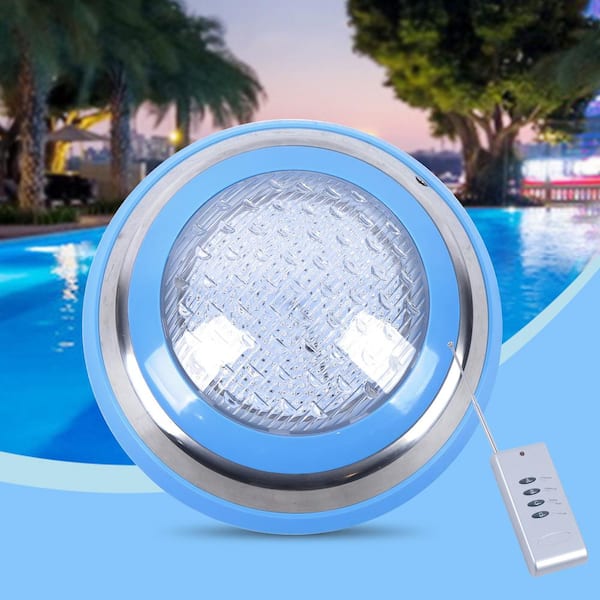
Before LEDs took over the market, halogen lighting was the top choice for pool and landscape lighting. They’re more efficient than a standard indoor bulb, and they’re still hard to beat when it comes to how bright they are.
Halogen pool lights have been a popular choice for illuminating swimming pools for many years. These lights utilize halogen bulbs, which produce bright and intense light, making them effective for lighting up larger pool areas. One of the main advantages of halogen pool lights is their brightness and clarity, providing excellent visibility for nighttime swimming and poolside activities. Additionally, halogen lights often have a warm and inviting glow, which can enhance the ambiance of the pool area.
However, there are some drawbacks to halogen pool lights as well. They tend to consume more energy compared to newer, more energy-efficient lighting technologies such as LED. Halogen bulbs also have a shorter lifespan and may require more frequent replacement, leading to higher maintenance costs over time. Furthermore, halogen lights generate more heat than LEDs, which can potentially affect water temperature and increase energy consumption for pool heating.
Overall, while halogen pool lights offer excellent brightness and aesthetics, pool owners may want to consider the long-term costs and environmental impact associated with their energy consumption and maintenance requirements. As LED technology continues to advance, many pool owners are opting to switch to LED pool lights for their energy efficiency, longer lifespan, and lower maintenance costs.
The problem with Halogen lights even that they are the best option for someone who has a bigger pool and the initial cost of installing these lights is less than LED lights.
There are a few good reasons that halogen lights have lost ground over the past few years especially compared to LEDs which last longer and are more energy-efficient. Plus, some pool owners have noted that halogen lights tend to run hot, which can be an uncomfortable surprise for unexpecting swimmers.
Conclusion:
In conclusion, both halogen and LED pool lights offer unique advantages and considerations for pool owners. Halogen lights provide bright and warm illumination, enhancing the ambiance of the pool area and ensuring excellent visibility for nighttime swimming. However, they tend to consume more energy and require more frequent maintenance compared to LED lights. On the other hand, LED pool lights are highly energy-efficient, have a longer lifespan, and offer customizable lighting options such as color-changing capabilities.
While they may have a higher upfront cost, LED lights often prove to be a more cost-effective and sustainable choice in the long run. Ultimately, the decision between halogen and LED pool lights depends on factors such as budget, energy efficiency goals, and desired lighting features, with both options offering effective solutions for illuminating and enhancing the enjoyment of swimming pools.
How Do You Replace a Pool Light?
- Turn on the pool light main breaker off to the swimming pool-light-pool light will turn off
- Remove Screw Holding Light Housing
- Remove the Light Housing
- Loosen Other Screws
- Remove Original Bulb
- Install the Replacement Bulb-LED low-voltage pool light
- Replace Pool Light Housing ………………………………………………………………………….. Read more

References:
HGTV-Swimming Pool Lighting Tips:
FAQ’s
Are solar pool lights effective for illuminating swimming pools? A: Solar pool lights can be effective for illuminating swimming pools, especially in areas with ample sunlight exposure. These lights utilize solar panels to collect energy from the sun during the day, which is then stored in batteries to power the LED lights at night. While solar pool lights are eco-friendly and do not require electricity from the grid, their effectiveness may vary depending on factors such as sunlight availability and desired brightness level.
Q: How do I install pool lights? A: The installation process for pool lights varies depending on the type of lights and your pool’s specific setup. Generally, it involves connecting the lights to a power source, either directly or through a transformer, and securing them in place according to the manufacturer’s instructions. For underwater lights, proper waterproofing and sealing are essential to prevent leaks and ensure safety. It’s recommended to hire a professional electrician or pool installer for installation to ensure compliance with safety regulations and proper functionality.
Q: How do I maintain pool lights? A: Regular maintenance is important to ensure the proper functioning and longevity of pool lights. This includes routine cleaning to remove debris and buildup, checking for any signs of damage or corrosion, and replacing bulbs or components as needed. It’s also essential to inspect the electrical connections and wiring periodically to prevent issues such as short circuits or electrical hazards. Following the manufacturer’s maintenance guidelines and scheduling professional inspections when necessary can help keep your pool lights in optimal condition.
How many pool lights do I need? A: The number of pool lights needed depends on factors such as the size and shape of your pool, desired brightness, safety considerations, and aesthetic preferences. As a general guideline, one powerful LED pool light can typically illuminate a standard-sized pool adequately. However, larger pools or those with irregular shapes may require multiple lights for full coverage and enhanced safety.
Q: What are the benefits of using LED pool lights over traditional halogen lights? A: LED pool lights offer several advantages over traditional halogen lights. They are much more energy-efficient, have a longer lifespan, and offer more versatility in terms of lighting options, such as color-changing capabilities and dimming features. LED pool lights also produce less heat, reducing strain on cooling systems and making them safer to use.

